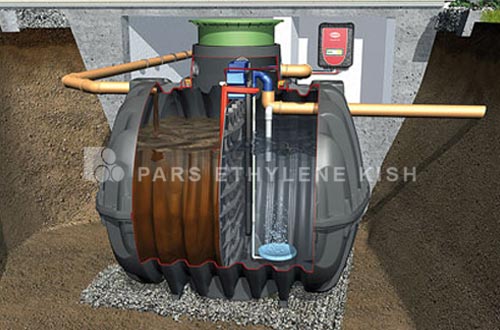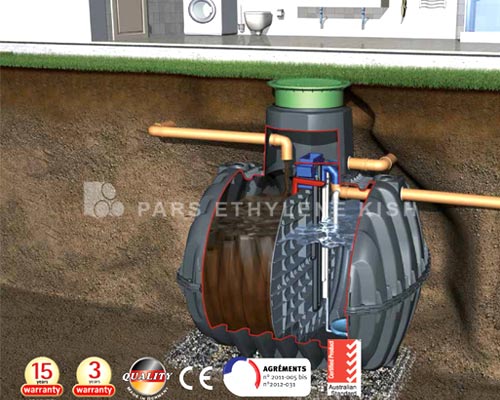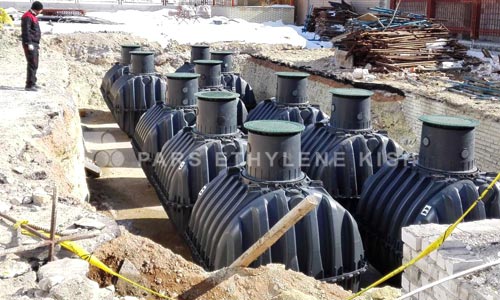
Comparing decentralized sewage treatment system with common central system
Today, when we speak about the selection of installation systems in the sewage treatment project, immediately the question of centralized or decentralized system raises which should be evaluated separately in order to select the best option for implementation by comparison of advantages and disadvantages.
For this purpose and regarding the conditions of the project, it is tried that by technical comparison of decentralized sewage treatment system method with centralized method, advantages and disadvantages of each method described.
Sewage collection and transfer pipelines
In installations engineering, pipelines which collect sewage from its source and direct gravimetrically under the ground, is called sewage transfer pipelines. These pipelines are from cement, cast-iron, polyethylene or polymer and in addition to being buried under the ground, they direct sewage with a slight gradient toward destination.
Diameter of pipes changes with the sewage discharge and regarding the climatic conditions, topography and soil type, depth of burying pipes varies from 50cm to 2m and is some areas, it may increase to several meters.
Sewage treatment centralized system
One of the important required infrastructures for sewage treatment centralized system is sewage collection and transfer system. Based on the site topography and length of pipelines, pump stations should be established in several points for transferring sewage that in addition of transfer network implementation costs, related costs of establishing pump station and its repair and maintaining should be considered in the total estimation. Regarding these conditions, it seems that cost of implementation and maintaining sewage transfer and pump station is higher than costs of establishing centralized treatment system.
Sewage treatment decentralized system
One of the most important advantages of decentralized sewage treatment packages is lack of need to collection and transfer network such that by implementation of buried tanks in the common space related to each type of buildings, sewage will transfer by the shortest path.
Place for establishment of sewage wastewater treatment plant and occupying land
Cost of land, land uses of nearby areas to wastewater treatment plant, direction of wind, safety, protection and cases like this are factors which influence the site engineering and location of wastewater treatment plant.
Sewage treatment centralized system
Location of wastewater treatment plans requires a closed separate place for changing undesired visual view of equipment and tanks and also observing safety and health issues which is protected in 24 ours.
Costs related to the construction of required buildings, personnel, maintaining and protecting it and also cost of buying land are costs which should be considered in total estimation of costs related to central systems.
Sewage treatment decentralized system
Another salient characteristics of the decentralized sewage systems, is burying the tanks and non-occupation of space on the ground and regarding that it is possible to load vertically and also develop green spaces on the tanks, we can say that by implementation of these packages, no space is occupied on the land and there is no need to wastewater treatment plant and is it preferred to centralized system in this regard.
Operation, maintaining, repairs and depreciation of sewage treatment plants
Sewage treatment centralized system
In common centralized sewage systems, due to presence of pumps and mechanical parts, failure is high and costly and during operation, operators and technicians are required in three work shifts.
Sewage treatment decentralized system
One of the advantages of decentralized sewage treatment packages which is emphasized by manufacturer is low depreciation, ease of use and low energy consumption. These cases are obtained by not using mechanical and electrical parts inside the tanks.
Energy consumption of sewage treatment systems
Cost of power in the sewage treatment systems is considerable during operation which should be considered when choosing optimal system.
Sewage treatment centralized system
Power consumption of this system is 1 to 3KWH per treatment of m3 sewage. For example, this is 2.1KWH in RBC system.
Sewage treatment decentralized system
In decentralized sewage treatment packages, the only energy consumer part is a compressor and this system consumes 58KWH power for treating one cubic meter sewage.
Operation in low load condition or peak of consumption
Sewage treatment centralized system
In designing centralized systems, normal capacity is estimated in full operation capacity of project.
Regarding that the process of forming active sludge in the centralized systems is time-consuming, generally, these systems reach to the best efficiency after initial operation. If sewage production minimizes or stops for any reason (vocation), the function of system distorts and wastewater will not treated completely.
Restoration of system and formation of new active sludge needs several days. These conditions exist when sewage input size is higher than central treatment systems.
An important point in the low load times is using total capacity of central system for treating low sewage volume which is not cost-effective and reduces treatment efficiency and wastewater quality.
Sewage treatment decentralized system
By using decentralized sewage treatment packages in the low load times, we can exclude one or several tanks from the line by considering the size of sewage and for excess input sewage, required provisions are considered in the design such that excess sewage overflows and when system return to normal condition, the system will resume its normal activity.

Implementation and operation time of sewage treatment plant
In some projects, due to special conditions, the most important option in choosing the system is required time for system implementation and operation.
Sewage treatment centralized system
For implementation of centralized systems in this project, collection network and pump station is required. Minimum time for implementation of sewage treatment plant and collection pipelines and pump station is more than 5 or 6 months.
Costs of constructing buildings required by sewage treatment plant, personnel and maintaining and cost of buying land are costs which should be considered in the total estimation of centralized systems.
Sewage treatment decentralized system
Because decentralized packages do not need collection and transfer network, required time for their implementation is 1 to 7 days.
Reuse of treated wastewater for irrigation of green space
Regarding the water deficit condition in the country, one of the water consumption saving methods is sewage recycling which is done by sewage treatment systems.
Sewage treatment centralized system
For using wastewater of sewage treatment system, this wastewater should be used after exiting the sewage treatment plant by a separate distribution network which includes pipelines and pump station. On the other hand, wastewater of centralized systems like RBC should pass complementary treatment processes for irrigation in order to be used. These steps are chlorination and clarification by sand filter. For discharging this wastewater to the sea, secondary filtration should be used for wastewater, i.e. wastewater should enter press filter after passing sand filter. In final estimation of buying cost and implementation of centralized systems in each project, costs of wastewater distribution network for irrigation of green space and implementation of centralized systems in the project, pump station and chlorination and filtration should be estimated separately and considered in total estimation.
Costs of constructing required buildings for sewage treatment plant, personnel, maintaining and buying land should be considered in total costs of centralized systems.
Sewage treatment decentralized system
Wastewater of decentralized packages has all required standards for irrigating green space or discharging to the sea and there is no need for complementary filtration operation in this wastewater and wastewater can be stored and used on that place and transmission and distribution network is nor needed.
Stopping sewage treatment system
In the case of stopping sewage treatment system (centralized or decentralized) for any reason (failure, periodic repairs, etc.), what happens in this project? The main concern is stopping the sewage treatment system and its consequences which will be analyzed in following.
Sewage treatment centralized system
Centralized systems should be stopped for discharging sludge or periodic repair (painting all metallic packages) in determined times and the sewage should be discharged.
On the other hand, by considering all defects and shortages in the remote areas that even trivial repair needs more time due to lack of skilled human labor or required part, in the case of failure of a mechanical or electrical part, system function may stop for several days.
In this case, some questions arise:
1. How many times a centralized sewage treatment plant which works in the hot and humid environment and its parts depreciated, fails in a year? How much are stop days for these failures?
2. Is treatment efficiency in the sewage treatment plans similar to first day after basic repairs and has wastewater the required standard?
3. How much sewage produces during stopping the operation of sewage treatment plant which sometimes may last more than one week? What should you do with this sewage volume?
4. Is there any way other than discharging raw sewage to sea and environment?
5. How much is the cost of removing the pollution from the sea water or soil of coast?
Sewage treatment decentralized system
The basic principle in designing and fabricating decentralized packages is minimizing depreciation and failure. Because tanks are made from polypropylene and internal pump mechanism, no corrosion occurs and periodic repairs are not necessary. Only depreciated parts of Pars Ethylene Kish packages are compressor and control kit that their required number will be provided by the company as spare parts of the project.
Each of these parts are diagnosed and replaced in less than 30 minutes by experts.
If one package fails or needs sludge discharge, because function of these systems are separate, there is no problem in other packages by stopping the failed package.
Comparing costs of implementation and operation in centralized and decentralized systems
In final estimation of installation costs in the construction project, the price of buying centralized systems is significantly lower than independent systems.
But in some projects, regarding the scope of the project ad its conditions, we should provide and implement required infrastructure that cost of implementing these infrastructures is sometimes several times of actual cost for buying centralized system.
Following table compares the cost of required infrastructures for centralized and decentralized methods.
|
Sewage treatment centralized system |
Sewage treatment decentralized system |
|
Considerable and high cost |
No cost |
|
Cost of buying land, landscaping, protection, operation |
No cost |
|
Considerable cost |
Low cost |
|
Cost higher than decentralized system |
Cost lower than centralized system |
|
Cost of transmission pipes, pump station, … |
No cost |
|
Cost of press filter and sand filter |
No cost |


